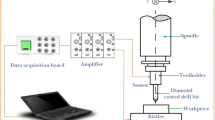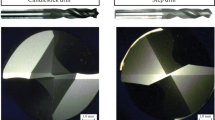Abstract
Drilling of carbon/carbon (C/C) composites is difficult to carry out due to its high specific stiffness, brittleness, anisotropic, non-homogeneous, and low thermal conductivity, which can result in tear, burr, poor surface quality, and rapid wear of tools. Three drilling methods including conventional twist drilling, rotary ultrasonic drilling, and high-speed drilling can all be used in hole making of composites in industry. To find a best method of hole making in drilling of C/C composites, a serials of comparison experimental tests using the same size cemented carbide drill are designed and performed in this paper. Thrust force, tool wear, and drilling defects are all analyzed and compared for different machining parameters for all the three drilling methods. The experimental results show that rotary ultrasonic drilling is the best choice in almost all these aspects in drilling of needle-punched C/C composites within the range of selected experimental machining parameters.
Similar content being viewed by others
References
Savage E (2012) Carbon-carbon composites. Springer Science & Business Media
Buckley J (1988) Carbon-carbon-an overview
Kim D, Ramulu M (2004) Drilling process optimization for graphite/bismaleimide–titanium alloy stacks. Compos Struct 63(1):101–114. https://doi.org/10.1016/S0263-8223(03)00137-5
Cong W, Pei Z, Deines T, Liu D, Treadwell C (2013) Rotary ultrasonic machining of CFRP/Ti stacks using variable feedrate. Compos Part B 52:303–310. https://doi.org/10.1016/j.compositesb.2013.04.022
Debnath K, Singh I, Dvivedi A (2014) Rotary mode ultrasonic drilling of glass fiber-reinforced epoxy laminates. J Compos Mater 49(8):949–963. https://doi.org/10.1177/0021998314527857
Yuan S, Zhang C, Amin M, Fan H, Liu M (2015) Development of a cutting force prediction model based on brittle fracture for carbon fiber reinforced polymers for rotary ultrasonic drilling. Int J Adv Manuf Technol 81(5–8):1223–1231
Ning F, Cong W, Pei Z, Treadwell C (2016) Rotary ultrasonic machining of CFRP: a comparison with grinding. Ultrasonics 66:125–132
Wang J, Feng P, Zhang J, Zhang C, Pei Z (2016) Modeling the dependency of edge chipping size on the material properties and cutting force for rotary ultrasonic drilling of brittle materials. Int J Mach Tools Manuf 101:18–27. https://doi.org/10.1016/j.ijmachtools.2015.10.005
Li Z, Jiao Y, Deines T, Pei Z, Treadwell C (2005) Rotary ultrasonic machining of ceramic matrix composites: feasibility study and designed experiments. Int J Mach Tools Manuf 45(12):1402–1411
Liu J, Baek D, Ko T (2014) Chipping minimization in drilling ceramic materials with rotary ultrasonic machining. Int J Adv Manuf Technol 72(9–12):1527–1535. https://doi.org/10.1007/s00170-014-5766-y
Ning F, Wang H, Cong W, Fernando P (2017) A mechanistic ultrasonic vibration amplitude model during rotary ultrasonic machining of CFRP composites. Ultrasonics 76:44–51. https://doi.org/10.1016/j.ultras.2016.12.012
Cong W, Pei Z, Feng Q, Deines T, Treadwell C (2012) Rotary ultrasonic machining of CFRP: a comparison with twist drilling. J Reinf Plast Compos 31(5):313–321
Cong W, Pei Z, Sun X, Zhang C (2014) Rotary ultrasonic machining of CFRP: a mechanistic predictive model for cutting force. Ultrasonics 54(2):663–675
Liu J, Zhang D, Qin L, Yan L (2012) Feasibility study of the rotary ultrasonic elliptical machining of carbon fiber reinforced plastics (CFRP). Int J Mach Tools Manuf 53(1):141–150. https://doi.org/10.1016/j.ijmachtools.2011.10.007
Campos Rubio J, Abrão A, Eustáquio Faria P, Correia A, Davim J (2008) Delamination in high speed drilling of carbon fiber reinforced plastic (CFRP). J Compos Mater 42(15):1523–1532. https://doi.org/10.1177/0021998308092205
Wang C, Cheng K, Rakowski R, Greenwood D, Wale J (2016) Comparative studies on the effect of pilot drillings with application to high-speed drilling of carbon fibre reinforced plastic (CFRP) composites. Int J Adv Manuf Technol 89(9–12):3243–3255. https://doi.org/10.1007/s00170-016-9268-y
Karnik S, Gaitonde V, Rubio J, Correia A, Abrão A, Davim J (2008) Delamination analysis in high speed drilling of carbon fiber reinforced plastics (CFRP) using artificial neural network model. Mater Des 29(9):1768–1776. https://doi.org/10.1016/j.matdes.2008.03.014
Campos Rubio J, Abrao A, Faria P, Correia A, Davim J (2008) Effects of high speed in the drilling of glass fibre reinforced plastic: evaluation of the delamination factor. Int J Mach Tools Manuf 48(6):715–720. https://doi.org/10.1016/j.ijmachtools.2007.10.015
Lin S, Chen I (1996) Drilling carbon fiber-reinforced composite material at high speed. Wear 194(1):156–162
Gaitonde V, Karnik S, Rubio J, Correia A, Abrao A, Davim J (2008) Analysis of parametric influence on delamination in high-speed drilling of carbon fiber reinforced plastic composites. J Mater Process Technol 203(1):431–438
Krishnaraj V, Prabukarthi A, Ramanathan A, Elanghovan N, Senthil Kumar M, Zitoune R, Davim J (2012) Optimization of machining parameters at high speed drilling of carbon fiber reinforced plastic (CFRP) laminates. Compos Part B 43(4):1791–1799. https://doi.org/10.1016/j.compositesb.2012.01.007
Shan C, Wang X, Yang X, Lyu X (2015) Prediction of cutting forces in ball-end milling of 2.5 DC/C composites. Chin J Aeronaut 29(3):824–830
Shan C, Lin X, Wang X, Yan J, Cui D (2015) Defect analysis in drilling needle-punched carbon-carbon composites perpendicular to nonwoven fabrics. Adv Mech Eng 7(8):1–11. https://doi.org/10.1177/1687814015598494
Funding
This work is supported by “the National Natural Science Foundation of China” (No. 51105312) and “the Fundamental Research Funds for the Central Universities (No. 3102017gx06007)”.
Author information
Authors and Affiliations
Corresponding author
Rights and permissions
About this article
Cite this article
Shan, C., Zhang, X., Dang, J. et al. Rotary ultrasonic drilling of needle-punched carbon/carbon composites: comparisons with conventional twist drilling and high-speed drilling. Int J Adv Manuf Technol 98, 189–200 (2018). https://doi.org/10.1007/s00170-017-1228-7
Received:
Accepted:
Published:
Issue Date:
DOI: https://doi.org/10.1007/s00170-017-1228-7




